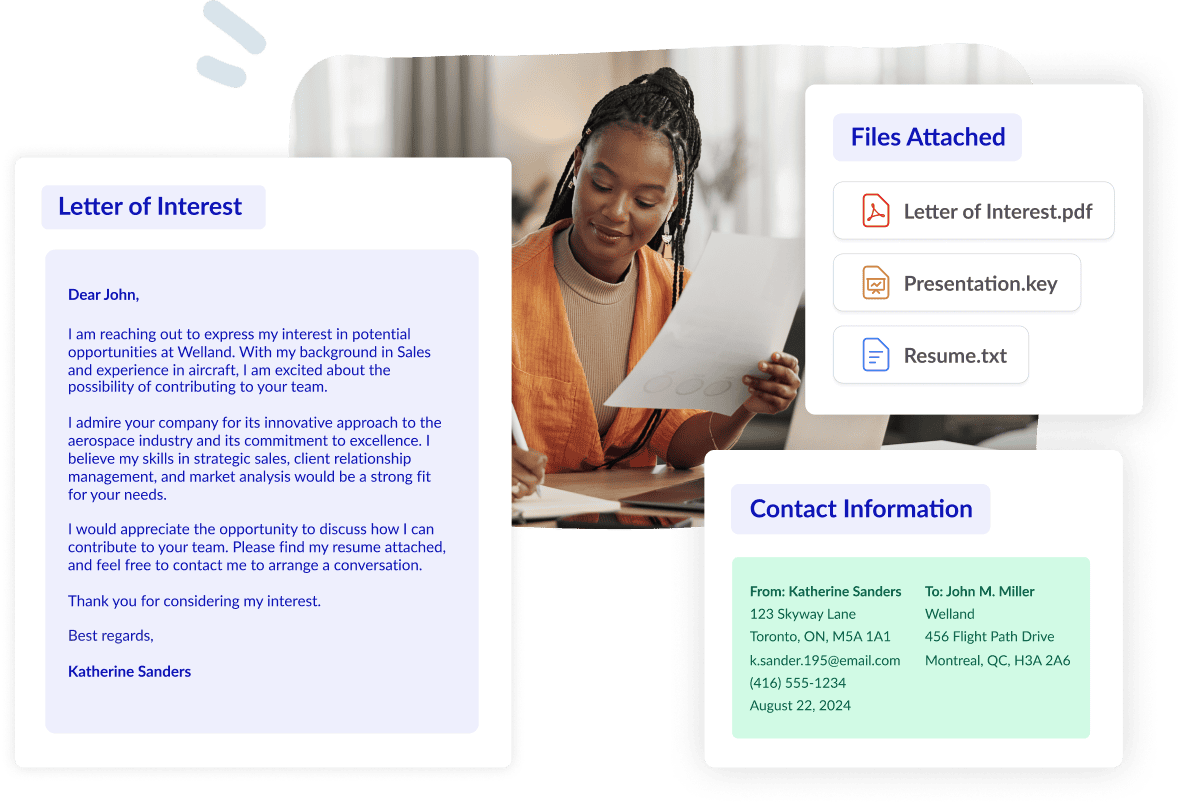
Use Exit Interviews To Improve Hiring
Learn how to get valuable insights to reduce turnover, improve the employee experience, and hire better.

Whether you're actively on the job hunt or simply open to new opportunities, there are likely a few companies you've had your eye on. You may admire the work they do and connect with their mission. Or it seems like a fun workplace with a vibrant company culture.
There's only one problem: they don't have any open roles that would fit you well. So what do you do? Wait for the right opportunity, or take the initiative to reach out first?
This is where a letter of interest comes into play. It's a way to let a company know you're interested in working there. It might feel like a bold move, but when done right, a letter of interest can open doors and lead to unique opportunities. In this article, you'll learn how to craft a compelling letter of interest that gets noticed.
So, what exactly is a letter of interest? What are the benefits, and is it the same as a cover letter? Let's break it down.

A letter of interest is a professional letter written to a potential employer to express your interest in working for them. It's a tool to let the employer know what you like about the organization and why you'd be a good fit and asset to their team so they will keep you in mind for future opportunities.

How many applications does the average job posting get?
According to research from StandOut CV, a “low-skilled” vacancy will receive 506 applications on average, and a “high-skilled” vacancy will receive 55.
We know what you’re probably thinking: is a letter of interest the same as a cover letter? Here are the main similarities and differences.
Letter of Interest
Similarities
Cover Letter
A type of cold outreach used when there is no specific job opening advertised for the position you want.
Tools to introduce yourself to a potential employer, add context to a resume, highlight skills and experiences, and show personality.
A supporting document for a job application, often required by the hiring manager.
More company-focused — answers the question, “Why do you want to work here?”
A professional letter that is customized to the company.
More role-focused — answers the question, “Why are you the best person for the job?”
You should write a letter of interest when a company has no public open position that aligns with your skills and experience. However, you're still interested in connecting with them to see if there might be other opportunities.
For example, if you:
Use a letter of interest to introduce yourself to a prospective employer. Share why you want to work for them and what you bring to the table so you’re in their talent pipeline when a role opens up. You can also use it to get your foot in the door and build a long-term relationship with the company.
What are the best and worst times to send a cold email?
According to research analysis from Coschedule, Thursday at 10 am is the best time, and Sunday between 7 pm and 2 am is the worst.

A letter of interest has five key parts:

Drafting and sending a letter of interest can feel daunting. You don't want to come across as too forward, but you don't want to spend time crafting a personal letter that gets lost in the shuffle.
Here are some common do's and don'ts to remember when preparing a letter of interest.
[Your Name]
[Your Address]
[City, State, Zip Code]
[Email Address]
[Phone Number]
[LinkedIn]
[Date]
[Hiring Manager’s Name]
[Company Name]
[Company Address]
[City, State, Zip Code]
Dear [Hiring Manager's Name],
I first learned about your company when [explain how you heard about the company].
I was immediately captivated by [what drew you in]. Since then, I've been following [Company Name] closely, admiring your approach to [specific work they do] and commitment to [a particular aspect of the company, like sustainability, innovation, or community impact]. That's when I knew I wanted to be a part of what you're building.
My name is [Your Name], and with [number] years of experience in [Your Industry/Field], I know I would be an asset to your team. At [Previous Company], I [specific achievement or responsibility related to the company's work]. I’m confident I could leverage what I learned and the skills I gained to help [Company Name] grow.
What excites me most about [Company Name] is [specific reason based on your research]. I'm particularly inspired by [mention any recent developments or initiatives you've learned about through your research], and I'm eager to contribute to these efforts.
I understand there may not be a specific opening right now, but I'd love to chat about potential roles or future opportunities with your team. I believe my experience in [specific skills or areas of expertise] and my enthusiasm for [industry/field] would make me a valuable addition to [Company Name].
Thank you for considering my letter. I've attached my resume, and I would love to discuss how I could contribute to [Company Name] further. If you're interested, please get in touch with me at [your phone number] or [your email address] at your convenience.
I am looking forward to connecting further.
Best regards,
[Your Name]
Sending a letter of interest can be nerve-wracking. It's normal to worry about whether it will even get read or if you will get a response. However, as the famous saying goes, "You miss 100% of the shots you don't take."
Even if you don't get an immediate response or a response at all, you took the initiative to make yourself known to the company. Plus, rather than waiting for a job to open up, it's a way to make the first move and take charge of your job search.
So, if there's a company you're excited about, consider sending them a letter of interest. It could be the key to unlocking your next big career move.

The ideal length for a letter of interest is less than one page long, or 200 to 300 words. It should be long enough to introduce yourself and explain why you're interested in the company but short enough to keep the reader's attention. Make every word count by including concrete examples that demonstrate the qualities you want to convey.
Your interest letter's introduction needs a solid hook to grab your reader's attention. For example, sharing your connection to the company or cause, a recent noteworthy achievement by the company, an inspirational moment, or a personal story are all great ways to draw the recipient in and encourage them to keep reading.
A simple interest letter has five essential parts: a header section, greeting, opening paragraph, body paragraphs, and conclusion. The ultimate goal is to introduce yourself, explain your interest in the company, highlight your relevant experience or skills, and share how you would contribute to the team.
Modernize your hiring process with expert insights and advice.